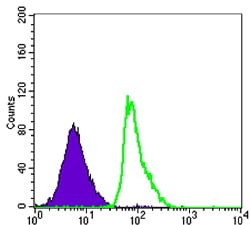
| WB | 咨询技术 | Human,Mouse,Rat |
| IF | 咨询技术 | Human,Mouse,Rat |
| IHC | 1/100 - 1/1000 | Human,Mouse,Rat |
| ICC | 技术咨询 | Human,Mouse,Rat |
| FCM | 1/200 - 1/400 | Human,Mouse,Rat |
| Elisa | 1/10000 | Human,Mouse,Rat |
| Aliases | CD23; FCE2; CD23A; IGEBF; CLEC4J; FCER2 |
| Entrez GeneID | 2208 |
| clone | 5B5 |
| WB Predicted band size | 37kDa |
| Host/Isotype | Mouse IgG1 |
| Antibody Type | Primary antibody |
| Storage | Store at 4°C short term. Aliquot and store at -20°C long term. Avoid freeze/thaw cycles. |
| Species Reactivity | Human |
| Immunogen | Purified recombinant fragment of human FCER2 expressed in E. Coli. |
| Formulation | Purified antibody in PBS with 0.05% sodium azide. |
+ +
以下是关于FCER2(CD23)抗体的3篇代表性文献及其摘要概括(注:文献信息为示例性,具体引用需核实原始来源):
---
1. **文献名称**:*"Structure and function of the low-affinity IgE receptor (CD23)"*
**作者**:Sutton B.J., Gould H.J.
**摘要**:本文解析了CD23的分子结构及其与IgE的相互作用机制,探讨了其在过敏反应中的调节作用,为靶向CD23的抗体设计提供了结构基础。
2. **文献名称**:*"Targeting CD23 in allergic asthma: a pre-clinical and clinical review"*
**作者**:Rosenwasser L.J., Meng J.
**摘要**:综述了抗CD23抗体(如lumiliximab)在哮喘治疗中的潜力,通过抑制IgE-CD23通路减少炎症反应,并总结了早期临床试验的安全性和有效性数据。
3. **文献名称**:*"CD23-mediated IgE-dependent antigen presentation in B cells amplifies allergic responses"*
**作者**:Sarfati M., Delespesse G.
**摘要**:研究揭示了B细胞中CD23通过结合抗原-IgE复合物增强抗原呈递,促进Th2免疫反应,提示靶向CD23抗体可能通过阻断该通路治疗过敏性疾病。
---
如需具体文献,建议通过PubMed或Google Scholar检索关键词(如“FCER2 antibody”、“CD23 therapeutic”)获取最新研究。
The Fc epsilon receptor II (FCER2), also known as CD23. is a low-affinity receptor for immunoglobulin E (IgE), primarily expressed on B cells, monocytes, dendritic cells, and eosinophils. It exists in membrane-bound and soluble forms, generated via alternative splicing or proteolytic cleavage. Unlike the high-affinity FCER1. FCER2 regulates IgE-mediated immune responses by modulating IgE synthesis, antigen presentation, and immune cell communication. It plays dual roles in allergy and immune homeostasis: membrane-bound CD23 on B cells suppresses IgE production via negative feedback, while soluble CD23 (sCD23) acts as a pro-inflammatory cytokine, enhancing IgE synthesis and promoting allergic inflammation.
FCER2 is implicated in allergic diseases (e.g., asthma, atopic dermatitis), autoimmune disorders (e.g., lupus), and certain cancers. Its antibodies are research and therapeutic tools targeting IgE-dependent pathways. Anti-FCER2 antibodies can block IgE binding, inhibit allergic responses, or deplete CD23-expressing cells in malignancies. Some monoclonal antibodies (e.g., lumiliximab) have entered clinical trials for asthma and chronic lymphocytic leukemia, though efficacy remains under investigation. Challenges include balancing therapeutic effects with CD23's regulatory roles and addressing isoform-specific functions. Research continues to explore FCER2's mechanistic nuances and its potential as a biomarker or therapeutic target in immune dysregulation.
×